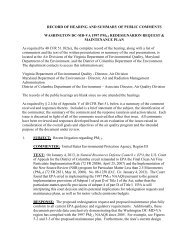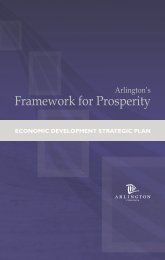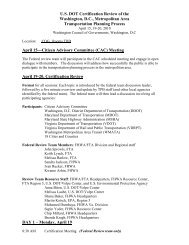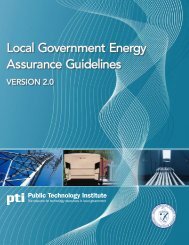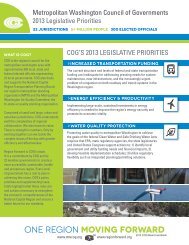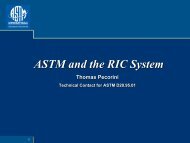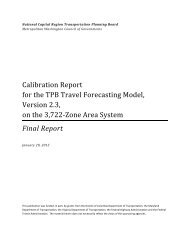Memo-CLRP Recommendations - Metropolitan Washington Council ...
Memo-CLRP Recommendations - Metropolitan Washington Council ...
Memo-CLRP Recommendations - Metropolitan Washington Council ...
You also want an ePaper? Increase the reach of your titles
YUMPU automatically turns print PDFs into web optimized ePapers that Google loves.
MEMORANDUM<br />
1<br />
DRAFT 10/13/08<br />
INTEGRATING FREIGHT INTO THE 2010<br />
CONSTRAINED LONG-RANGE TRANSPORTATION PLAN (<strong>CLRP</strong>)<br />
DATE: October 13, 2008<br />
TO: Freight Subcommittee<br />
Ron Kirby<br />
Gerald Miller<br />
Andrew Meese<br />
FROM: Karin Foster<br />
This memorandum provides a detailed outline for a report on integrating freight into the<br />
2010 <strong>CLRP</strong>. We hope to receive valuable freight stakeholder feedback as we strengthen<br />
our draft outline. It is recommended that a complete report be developed based on this<br />
outline for presentation to the National Capital Region Transportation Planning Board<br />
(TPB) in the spring of 2009.<br />
I. INTRODUCTION<br />
1. SAFETEA-LU<br />
The 2005 Safe, Accountable, Flexible, Efficient, Transportation, Equity, Act─A Legacy<br />
for Users (SAFETEA-LU) transportation bill identified freight planning as a key<br />
consideration for metropolitan planning. Gradually, more freight emphasis is being<br />
added to transportation legislation and more freight-related studies are being<br />
commissioned. At present, the freight community is awaiting any new enhancements that<br />
may come with the next transportation authorization bill following the expiration of<br />
SAFETEA-LU on September 30, 2009.<br />
2. Freight in the <strong>CLRP</strong><br />
The National Capital Region TPB is the federally required <strong>Metropolitan</strong> Planning<br />
Organization (MPO) for the <strong>Metropolitan</strong> <strong>Washington</strong> Region. The Constrained Long<br />
Range Plan (<strong>CLRP</strong>) is approved by the TPB every four years as required by the February<br />
2007 Federal Rules and Regulations. Each member jurisdiction must compile and submit<br />
financial information to TPB staff. This information reflects the anticipated federal,<br />
state, local, private, and other revenue each jurisdiction has available or is forecast to<br />
receive. Next each jurisdiction submits their constrained list of transportation projects<br />
(including highway, transit, bikeway, pedestrian, and private-investment projects). This<br />
information is all compiled into the <strong>CLRP</strong>. TPB board members must ultimately come to<br />
consensus on their regional transportation <strong>CLRP</strong>.<br />
In the 2007 <strong>CLRP</strong>, freight planning was mentioned as a one-page element, but no freight<br />
transportation projects were listed. This memorandum aims to build a process to pursue<br />
multi-modal freight issues and projects for the 2010 <strong>CLRP</strong>.
2<br />
DRAFT 10/13/08<br />
3. Goals for the 2010 <strong>CLRP</strong><br />
Our goals for the 2010 <strong>CLRP</strong> are to expand upon and improve the integration of freight<br />
planning issues into the document. What follows is an abbreviated schedule for the<br />
development of the 2010 <strong>CLRP</strong>:<br />
─Public meeting in September 2009<br />
─Call for projects issued October 2009<br />
─Project submissions December 2009<br />
─Project submissions approved February 2010<br />
─Following conformity analysis and public comment, approval by TPB July 2010<br />
4. Work Plan for 2009<br />
Prepare a report entitled Integrating Freight Into the 2010 Constrained Long-Range Plan.<br />
The report should include topics on freight planning, forecasts, issues, stakeholder<br />
perspectives, and key projects. The report should be ready for presentation to the TPB<br />
Technical Committee in March/April of 2009 and to the TPB in April 2009, for<br />
finalization by June 30, 2009.<br />
II. FREIGHT MOVEMENT IN THE METROPOLITAN WASHINGTON<br />
REGION: DATA AND FORECASTS<br />
1. FY 2007 Regional Freight Planning Study (CSI)<br />
Review the Enhancing Consideration of Freight in Regional Transportation Planning<br />
report by CSI and summarize findings. Pull-out the most relevant data and maps from<br />
the report. Identify locations of distribution centers/activity centers listed in the report,<br />
and discuss the changing trends.<br />
Partial List of Graphics and Maps from CSI report:<br />
─Top Trading Partners Inbound by value and tonnage for 2002<br />
─Top Trading Partners Outbound by value and tonnage for 2002<br />
─Air Cargo Airports in the <strong>Washington</strong> Region 2006<br />
─Estimated Regional Traffic Volumes % Change 2002-2030<br />
─Estimated Regional Truck Counts<br />
─<strong>Washington</strong> Region Trackage Rights and Ownership<br />
─<strong>Washington</strong> Region Rail Density 2006<br />
─<strong>Washington</strong> Region Petroleum Pipeline Terminals<br />
2. Additional Data Sources<br />
It is estimated by the Freight Analysis Framework, a division of the Freight Management<br />
and Operations Department at the Federal Highway Administration of the U.S.<br />
Department of Transportation that the <strong>Metropolitan</strong> <strong>Washington</strong> Region is projected to<br />
see the amount of tonnage moving to, from, and within the region to increase by 110<br />
percent and the value to increase by 145 percent by 2030. 1 It is important that we<br />
1 . Quoted in Enhancing Consideration of Freight in Regional Transportation Planning, Cambridge<br />
Systematics, Bethesda, MD, May 2007, p2-30.
3<br />
DRAFT 10/13/08<br />
identify additional data sources available to strengthen our Freight Program to better<br />
understand these freight trends.<br />
The Continuous Airport Systems Planning (CASP) Program also collects data that may<br />
be valuable for Freight Subcommittee discussions. For example, Tim Canan on TPB<br />
staff presented at the July 24, 2008 Freight Subcommittee meeting on the 2008<br />
<strong>Washington</strong>-Baltimore Regional Air Cargo Study. Collection of this data helps us to<br />
understand the number of truck trips in and out of the airport region.<br />
What additional land use maps from existing public data are available? How can we get<br />
data on the number of local internet purchase deliveries made by commercial shippers<br />
(e.g. UPS and PeaPod deliveries).<br />
Global Insight is a private data company that specializes in economic, financial, and<br />
political coverage of countries, regions, and industries─covering over 200 countries and<br />
spanning more than 170 industries. Their TRANSEARCH database is one example of a<br />
unique combination of data. TRANSEARCH database estimates what commodities are<br />
flowing between regions and where commodities are flowing to. A new TRANSEARCH<br />
update was completed in July 2008. Global Insight also has a Freight Locator Database.<br />
This is a database of shipping establishments. Perhaps this TRANSEARCH or Freight<br />
Locator data could support our analysis and modeling efforts in the future.<br />
3. TPB Travel Forecasts<br />
─Review recent upgrades to the TPB travel model with Jim Hogan/Mark Moran in<br />
training.<br />
Version 2.2, commercial vehicles<br />
Version 2.3, heavy trucks upgrade<br />
─Discuss with Ron Milone new counts, new VMT, new forecasts in the model, and how<br />
truck movements fit into the model.<br />
─Review TPB Travel Forecasting Model Version 2.2 Users Guide, truck sections.<br />
─Medium/Heavy/CV/Total truck forecasts through 2030.<br />
─Percent total regional VMT attributable to CV and to heavy trucks.<br />
─Discuss with Patrick Z. the 1996 Internal/External truck survey and the 2003 truck<br />
survey.<br />
─What does the 2007 <strong>CLRP</strong> offer for trucks and commercial vehicle and freight<br />
stakeholders?<br />
4. Rate of Growth through 2030<br />
─Rate of growth of commercial and truck traffic.<br />
─Commercial vehicles, trucks, versus overall VMT.<br />
─Proportion of CV and heavy trucks that are through trips.<br />
III. NATIONAL STUDIES AND COMMITTEES<br />
─Guidebook for Integrating Freight into Transportation Planning and Project Selection<br />
Processes, National Cooperative Highway Research Program Report 594, <strong>Washington</strong><br />
D.C. 2007.
4<br />
DRAFT 10/13/08<br />
The purpose of the Guidebook is to allow states and MPOs to better integrate freight<br />
issues throughout the transportation planning and programming process. The Guidebook<br />
identifies and discusses seven key elements of freight planning and programming: (1)<br />
Freight point of contact/technical lead; (2) Understanding regional freight system; (3)<br />
Linking freight planning and transportation planning and programming activities; (4)<br />
Freight data needs assessment and collection; (5) Effective outreach; (6) Freightrelated<br />
training and outreach opportunities; (7) Advocacy. The Guidebook also<br />
identified and described over 20 best practices from states and MPOs.<br />
http://onlinepubs.trb.org/onlinepubs/nchrp/nchrp_rpt_594.pdf<br />
─Enhancing Consideration of Freight in Regional Transportation Planning, Cambridge<br />
Systematics, Bethesda, MD, May 2007.<br />
This report provides a context of state and local freight planning activities and a freight<br />
profile for the <strong>Metropolitan</strong> <strong>Washington</strong> Region. The report offers recommendations on<br />
building up a Freight Program and Freight Subcommittee.<br />
http://www.mwcog.org/uploads/committee-documents/bF5fW1pX20080222142629.pdf<br />
─Federal Highway Administration Talking Freight Monthly Seminar. FHWA program,<br />
run by SAIC-Jennifer Symoun, ongoing.<br />
Talking Freight is a monthly freight-related Seminar Series sponsored by the Federal<br />
Highway Administration and managed by SAIC. The sessions are recorded and available<br />
on the FHWA Web Site. http://www.fhwa.dot.gov/freightplanning/talking.htm<br />
─Freight Rail Bottom Line Report, American Association State Highway and<br />
Transportation Officials, <strong>Washington</strong> D.C. 2007.<br />
This report describes the freight-rail industry, analyzes its benefits to the nation, estimates<br />
investment needs and the capacity to meet these needs and quantifies the consequences of<br />
not investing in freight rail, including the impact on highway congestion. The report<br />
highlights that relatively small public investments in the nation’s freight railroads can be<br />
leveraged into relatively large public benefits for the nation’s highway infrastructure,<br />
highway users, and freight shippers.<br />
http://freight.transportation.org/doc/FreightRailReport.pdf<br />
─Report of the National Surface Transportation and Revenue Study Commission:<br />
Transportation for Tomorrow, National Surface Transportation Policy and Revenue<br />
Study Commission, <strong>Washington</strong> D.C., December 2007.<br />
Lack of funding has been the root problem for several transportation projects, especially<br />
freight-oriented truck, rail, or intermodal projects that do not easily fit into an existing<br />
highway or rail programs. This report examines the historical “TEA” funding methods<br />
and offers a new proposed Federal Surface Transportation Program that would shrink our<br />
current 108 Programs down to 10 Programs areas. The second of the ten proposed<br />
Federal Surface Transportation Programs addresses freight; “Freight Transportation: A<br />
Program to Enhance U.S. Global Competitiveness.”<br />
IV. STAKEHOLDER PERSPECTIVES
5<br />
DRAFT 10/13/08<br />
1. Who are the Stakeholders?<br />
As a metropolitan region with relatively few major freight facilities, it is a challenge to<br />
identify key players in the freight community. An initial list is as follows:<br />
Private Sector Participants:<br />
─Commercial Trucking<br />
-Shippers: (e.g. UPS, FedEx, DHL, PeaPod)<br />
─Heavy Haulers/Tractor-Trailer<br />
-Swift, Roadway Express, Yellow Freight<br />
─Class I Freight Rail<br />
-CSX Transportation<br />
-Norfolk Southern<br />
─Warehouses/distribution centers<br />
-Safeway distribution center<br />
─Air cargo shippers (e.g. UPS, FedEX, DHL)<br />
─Transportation Consultants (e.g. Cambridge, Delcan)<br />
Public Sector Participants:<br />
─Government Agencies (Federal, State, County/local)<br />
-FHWA Office of Freight<br />
-Maryland DOT-Office of Freight Logistics representative<br />
-Virginia DOT-Office of Planning representative<br />
-District of Columbia DOT-Office of Planning representative<br />
-Local Jurisdictions<br />
-National Capital Planning Commission (NCPC)<br />
Associations:<br />
-Maryland Motor Truck Association (MMTA)<br />
-AASHTO (including Rail, Highway, Water, Intermodal Committees)<br />
-I-95 Corridor Coalition (I95)<br />
-Freight Stakeholder (DC)<br />
-America Trucking Association (ATA)<br />
MPOs/Universities<br />
-Baltimore <strong>Metropolitan</strong> <strong>Council</strong> (BMC)<br />
-Delaware Valley Regional Planning Commission (DVRPC)<br />
-George Mason University (GMU)<br />
We aim to gradually expand our Freight Subcommittee so there is a good mix between<br />
private sector and public sector freight participants. With additional diversity to our<br />
group of Freight Subcommittee members, we will have a more compelling case to make<br />
to the TPB for the policy issues and projects raised.<br />
We also need to work to maintain the contacts we have. In addition to building up<br />
membership of the Freight Subcommittee, we should meet with a range of individuals in<br />
the freight field to get outside ideas on how we can strengthen the Freight Program.
6<br />
DRAFT 10/13/08<br />
2. Regional Freight Subcommittee Overview<br />
We hold quarterly meetings for the Freight Subcommittee. We communicate with our<br />
freight stakeholder community through monthly e-newsletters and TPB staff participation<br />
in freight-related events outside the office. There are currently 89 contacts on our<br />
distribution list.<br />
The Freight Subcommittee should hold regular meetings with a consistent format. Each<br />
meeting will address some regular items and feature a new issue or project item. We will<br />
hold the Freight Subcommittee meetings at least each quarter with an occasional out-ofoffice<br />
meeting such as a site tour. This would help the Freight Subcommittee to build<br />
rapport amongst themselves and would help members learn about eachothers freight<br />
roles. In addition, an occasional Freight Subcommittee update to the TPB by a Freight<br />
Subcommittee member would help to increase the visibility of goods movement in the<br />
<strong>Metropolitan</strong> <strong>Washington</strong> Region.<br />
The Freight Subcommittee is building its membership. Our first two Freight<br />
Subcommittee meetings both had a handful of public sector and association<br />
representatives. The three <strong>Metropolitan</strong> <strong>Washington</strong> Region state DOTs have<br />
participated. Federal and state representatives are important public-sector stakeholders to<br />
participate at Freight Subcommittee discussions. We also had valued participation from<br />
the American Trucking Association and Maryland Motor Truck Association, to name a<br />
few. A goal of the Freight Subcommittee is to establish relationships with freight<br />
stakeholders from private industries whom could represent their industry in<br />
Subcommittee discussions.<br />
Freight generators tend to cluster in a location with freight-related land use. Sample<br />
clusters in the area include the New York Avenue Cluster in <strong>Washington</strong> D.C., the Dulles<br />
Airport Cluster in Virginia, and the Jessup/Elkridge/Savage Cluster in Maryland. The<br />
Subcommittee would value additional members who work in distribution and<br />
warehousing. As a way to gain participation, TPB staff will work to personally invite<br />
targeted guests before quarterly meeting.<br />
One specific task to be completed as soon as possible is the identification of a Freight<br />
Subcommittee Chair and/or a Freight liaison to the TPB. Having a public-sector Freight<br />
Subcommittee Chair who has a seat on the TPB would add value and provide an<br />
important link between our Freight Subcommittee and the TPB. S/he would help to<br />
promote Freight Subcommittee concerns to the TPB.<br />
Meetings to Date<br />
We have been able to kick-off our first two Freight Subcommittee meetings with good<br />
attendance. About fifteen participants attended each meeting, but we need to identify<br />
additional private sector individuals in freight-related industries for greater industry<br />
input.
7<br />
DRAFT 10/13/08<br />
April 24, 2008─At the kick-off meeting, Marygrace Parker of the I-95 Corridor Coalition<br />
presented on several freight-related projects that the I-95 Corridor Coalition has<br />
underway such as the Mid-Atlantic Truck Operations Study and the Mid-Atlantic Rail<br />
Operations Study. Andrew Meese of TPB staff gave a presentation on the May 2007<br />
Enhancing Consideration of Freight in Regional Transportation Planning report.<br />
Finally, Karin Foster of TPB staff made a basic presentation on integrating freight into<br />
the TPB Planning Process.<br />
July 24, 2008─Our second Freight Subcommittee meeting was held in July 2008 and<br />
Stephen Flippin of CSX Railway presented on the National Rail Gateway Project. His<br />
presentation was followed by TPB staff’s Tim Canan’s presentation on the Continuous<br />
Airport Systems Planning (CASP) Program. Mr. Canan briefed the Freight<br />
Subcommittee on the 2008 <strong>Washington</strong>-Baltimore Regional Air Cargo Study that was<br />
completed in June 2008. The study was last completed in 1997.<br />
Future Meetings<br />
October 16, 2006─We are in the process of planning a meeting for October 16, 2008.<br />
The idea is to have a shorter meeting at COG in the morning to discuss with our freight<br />
stakeholders the Draft Integrating Freight Into the 2010 Constrained Long Range Plan<br />
document for feedback. This would be followed by a tour of CSX Virginia Avenue<br />
Tunnel and Benning Yard for a limited number of people.<br />
January 15, 2009─9:00-11:00 a.m.<br />
Potential Agenda Topics: Truck routes in the <strong>Washington</strong> Region?<br />
Update on Status of federal transportation authorization for<br />
FY2010-2015<br />
April 16, 2009─9:00-11:00 a.m.<br />
Potential Agenda Topics: Survey results presentation and potential projects discussion.<br />
Update on Status of federal transportation authorization for<br />
FY2010-2015<br />
July 16, 2009─9:00-11:00 a.m.<br />
Potential Agenda Topics: Update on National Gateway study<br />
Freight Rail relationship to Commuter Rail<br />
Appendix I contains a list of possible Agenda Topics for future meetings. TPB freight<br />
planning staff will continue to network with other freight groups inside and outside the<br />
region to build our network and learn about new freight topics.<br />
3. Stakeholder Outreach and Input into TPB Process<br />
Freight Stakeholder Survey<br />
An important next step would be to conduct a Freight Stakeholder Survey that seeks to<br />
understand the freight stakeholder community issues of interest and to potentially identify<br />
freight transportation improvement projects. For example, a recent <strong>Washington</strong> Post
8<br />
DRAFT 10/13/08<br />
article, Traffic Cure Worsens the Pain, by Eric M. Weiss, describes how congestion is<br />
impacting businesses delivering goods and even school buses dropping students off at<br />
school. The effect has some businesses relocating or buying additional vehicles to make<br />
deliveries on time. 2 Surveys could help provide the input we need to help develop a<br />
collaborative Freight Work Program. TPB staff can draft a survey this fall based on the<br />
survey provided in Enhancing Consideration of Freight in Regional Transportation<br />
Planning. TPB staff can build off this survey and discuss it with a few key freight<br />
community members for their input before mass distribution. The survey can be e-mailed<br />
out to the current freight distribution list with 89 contacts. The results from this survey<br />
can be used to help identify the Freight Subcommittee’s goals for a work program and to<br />
pursue future meeting topics and potential freight transportation projects.<br />
Another task is to contact state and regional jurisdictions to identify their freight goals.<br />
Work to come up with a set of freight goals for the region that is representative of<br />
coordinated freight goals. Come up with objectives for each goal. Each project would be<br />
identified as relating to one of these goals.<br />
e-Newsletter and Web Site<br />
Maintain a monthly e-newsletter to keep the freight community up-to-date on what’s<br />
coming up in the freight community at TPB and around the region. Send out the<br />
newsletters around the first of each month for regularity. In addition to the e-Newsletter,<br />
maintain the Freight Subcommittee page on the COG/TPB Web Site with relevant<br />
meeting materials and other information.<br />
V. ISSUES AND PRIORITIES<br />
1. Stakeholder Issues and Concerns<br />
─Results of Stakeholder Survey<br />
─Other sources (e.g. CSX National Gateway Study by DMJM)<br />
─Access to toll lanes for Commercial Vehicles and Heavy Trucks (ICC Yes/HOT No)<br />
─Rail freight chokepoint at Virginia Avenue Tunnel and others<br />
─Freight Rail relationship to Commuter Rail<br />
2. Topics for Priority Attention at Freight Subcommittee and in 2010 <strong>CLRP</strong><br />
─Freight rail tunnels in <strong>Washington</strong> D.C.<br />
─<strong>Washington</strong> D.C. region truck routes, develop present day/future forecast truck maps<br />
─<strong>Metropolitan</strong> region truck loading/unloading areas<br />
─Congestion effects on trucks/commercial vehicle<br />
─Safety and security<br />
3. <strong>Recommendations</strong> for Projects to be Considered in 2010 <strong>CLRP</strong> Update<br />
As the federal government drafts the federal transportation authorization for FY2010-<br />
2015 the Freight Subcommittee has an immediate opportunity to identify potential freight<br />
projects for federal support. If the Freight Subcommittee can identify a regional project<br />
2<br />
. Eric M. Weiss, Traffic Cure Worsens the Pain: Fleets Expand to Beat Jams but Cause Some of Their<br />
Own, <strong>Washington</strong> Post, Monday, October 06, 2008, pA01.
9<br />
DRAFT 10/13/08<br />
that we can jointly support with member jurisdictions and organizations, such as the I-95<br />
Corridor Coalition, perhaps we can get this project into the 2010 <strong>CLRP</strong>. TPB staff will<br />
work with Freight Subcommittee members to identify the top five truck and rail<br />
bottlenecks/projects/problems that could enhance freight transportation movement in the<br />
region (e.g. rail clearance, pothole, signage, etc.) if addressed. Once these projects are<br />
identified through the survey and discussions at Freight Subcommittee meetings and<br />
through individual conversations with freight stakeholders, the Freight Subcommittee can<br />
work these projects move through the regular transportation planning process. Once we<br />
have these projects identified, we can identify each one’s multi-modal benefits (e.g.<br />
emission reductions, reduce truck delay, reduce train delay, etc.) to gain public<br />
recognition.<br />
Someone from our Freight Subcommittee can periodically present updates to the TPB<br />
and project proposals. This will help build energy and momentum amongst the TPB<br />
members that truck and rail freight issues are an important concern in our region. In<br />
addition to presenting these projects to the TPB, we can develop a flier to help market<br />
these projects.
Appendix 1:<br />
List of Potential Freight Subcommittee Meeting Topics/Issues to Address<br />
10<br />
DRAFT 10/13/08<br />
# Freight Subcommittee Discussion Topics/Ongoing Freight Issues<br />
TRUCK<br />
1 Truck congestion/unreliability for truck deliveries/just in time<br />
2 Lack of truck parking<br />
3 Short haul in the region of sand/gravel/etc. (Gary Davig's company)<br />
4 DDOT and Loading Zone Fare (article and Bill Howland letter)<br />
5 Georgia Truck Lane Study http://www.gatrucklanestudy.com/<br />
6 Road Maintenance<br />
7 No Trucks on Toll Roads (Va Toll Roads), Trucks allowed on ICC<br />
8 Bring in Trucker or Truck Company Owner<br />
9 RAIL<br />
10 Rail Crossings<br />
11 Rail Tunnels (Virginia Street Tunnel)<br />
12 NCPC Rail Study<br />
13 AIR<br />
14 Air Cargo Growth at Dulles, Reagan, BWI-fastest growing mode<br />
15 Air Cargo Survey updates (Update from 1995)<br />
16 MARITIME<br />
17 Coastal Shipping, move trucks to maritime highway<br />
18 "Freight Suburb" to Baltimore, Port of Baltimore, Short Sea Shipping<br />
19 ENVIRONMENT<br />
SmartTransport-EPA truck emissions program (LEED)<br />
20 Clean Trucks<br />
21 OTHER<br />
22 FedEx-Logistics (Monica Fleischmann)<br />
23 RFID tags and logistics/Walmart requiring RFID tags<br />
24 Transportation Infrastructure Bank Concept<br />
25 Safety<br />
26 Story of our Freight is the Story of our location-Freight Suburb<br />
27 Nearby Safeway distribution center logistics<br />
28 Construction sector<br />
29 Top 10 Freight Projects/Bottlenecks for Rail and Truck<br />
30 Freight security/HMS<br />
31 Visualization to Solve Problems in Freight Transportation (See Rolf Scmitt article in TR News)<br />
32 Freight Data Collection TRANSEARCH from VA and MD and GI<br />
33 Survey Freight stakeholders for topics of interest<br />
SmartPark Real Time Truck Parking Information (Jeff Secrist)<br />
34 HOT lanes



